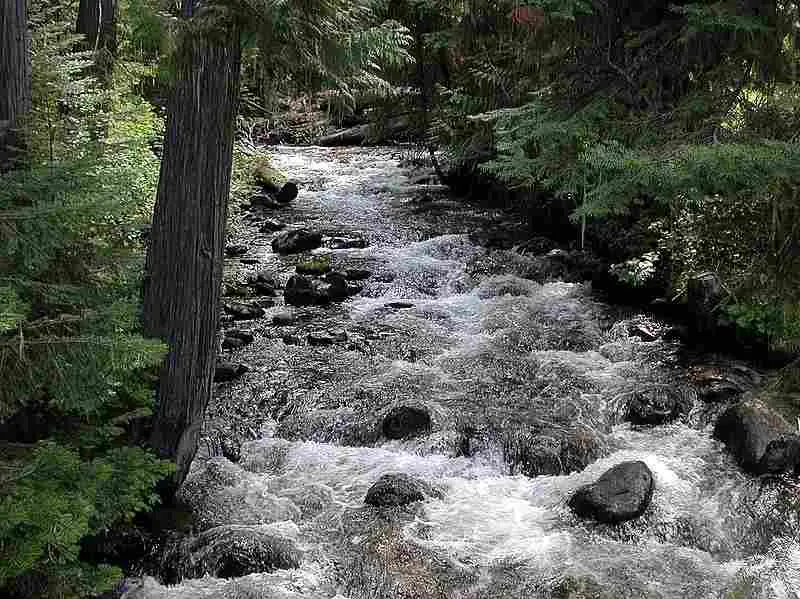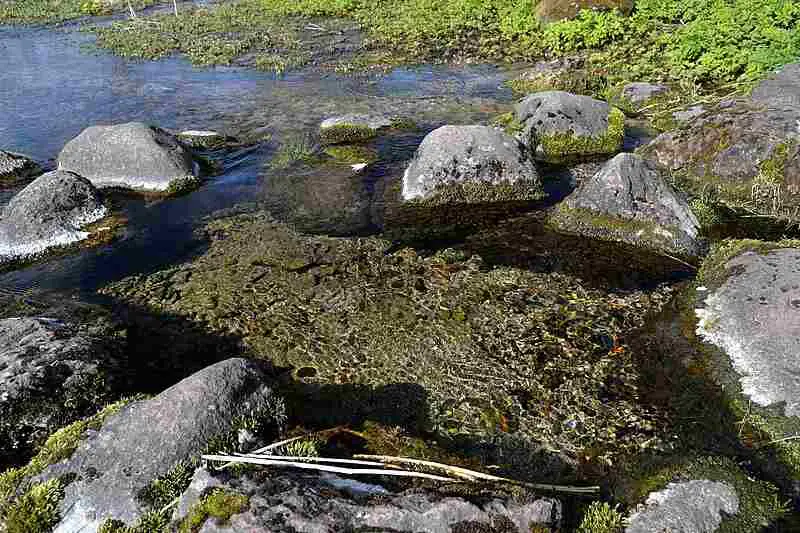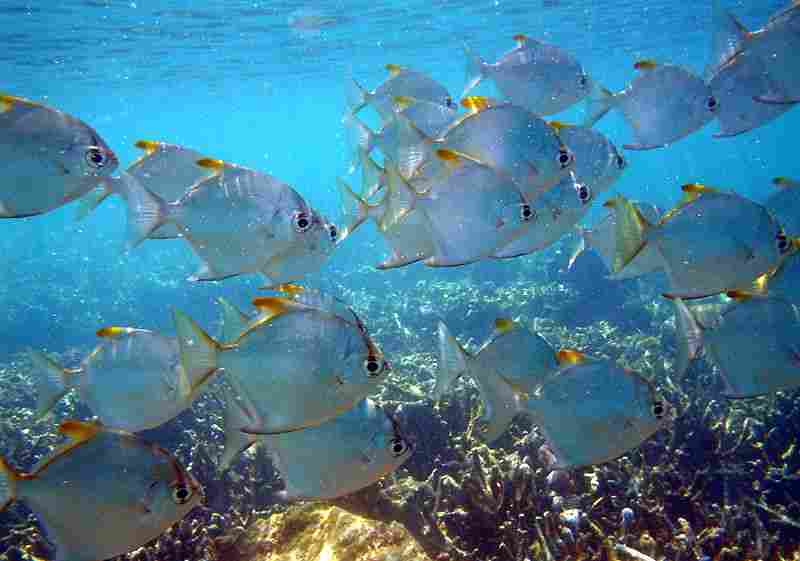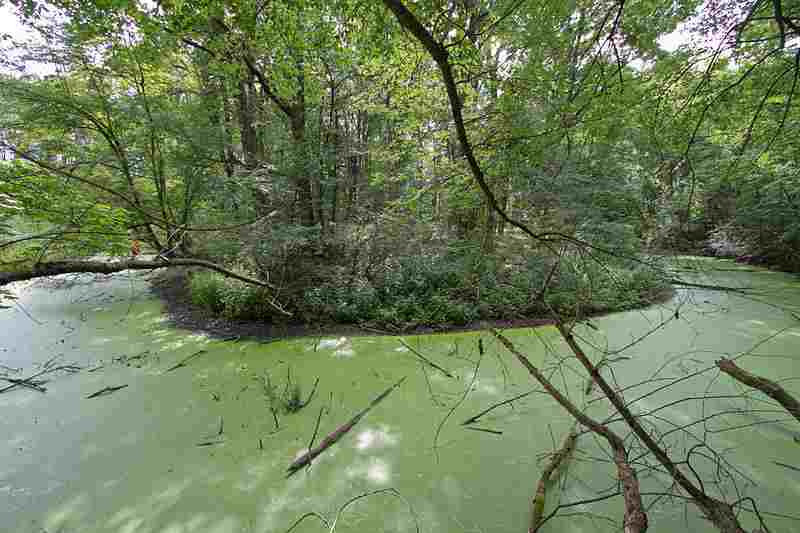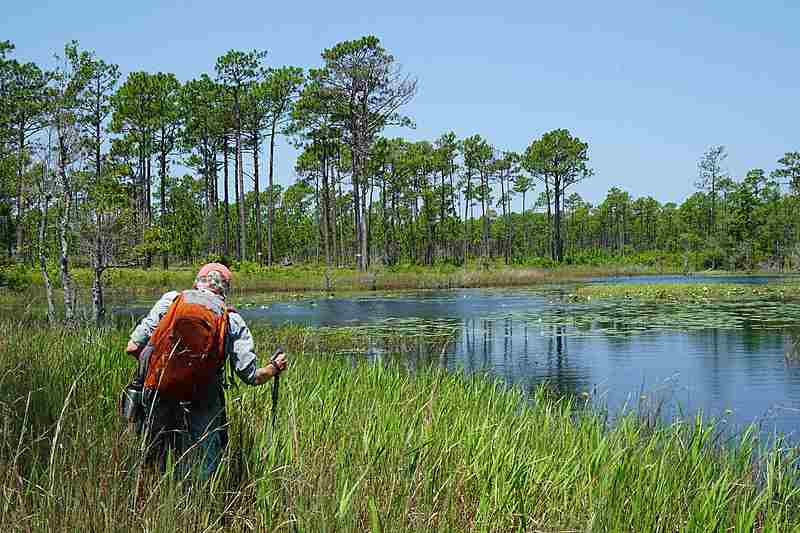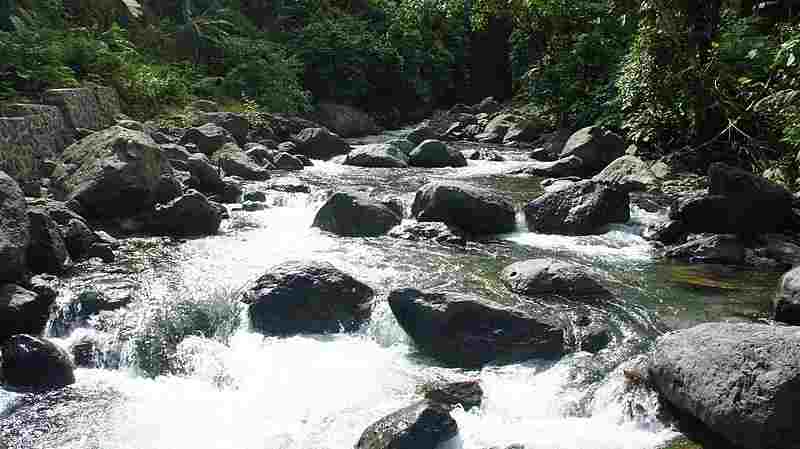9 Abiotic Factors in a River Ecosystem and Their Significance
Abiotic factors in a river are; sunlight, water, dissolved oxygen, sediments, rocks, physicochemical parameters, nutrients, topography, and flow trend.
This article discusses the abiotic factors in a river ecosystem, as follows;
1). Sunlight (as one of the Abiotic Factors in a River Ecosystem)
Sunlight, as an abiotic component of river ecosystems, has a crucial function in establishing and modifying the structure of these aquatic environments.
This section discusses the significance of sunlight in rivers, and how it affects this ecosystem.
Significance of Sunlight in River Ecosystems
The significance of light from solar radiation, in river ecosystems, can be traced to factors like primary production, oxygen cycling, temperature regulation, and food web dynamics. It can be said that light energy from the sun, serves as a link between abiotic and biotic factors in a river.
Sunlight is the primary energy resource that is needed for photosynthesis in hydrophytes, benthic algae, and phytoplankton. These photosynthetic organisms transform sunlight into chemical bioenergy, creating organic biomass from inorganic raw materials like carbon dioxide and water.

This process, known as primary production; constitutes the foundation of aquatic food chains. It provides the energy base for herbivores, which are subsequently consumed by predatory organisms in higher trophic levels.
Penetration of sunlight into the water column is crucial for the photosynthesis, growth and survival of aquatic autotrophs. In rivers with a clear water column, sunlight can penetrate to greater depths, allowing submerged plants to photosynthesize with optimal efficiency. These autotrophs provide essential microhabitat, food, and oxygen among other resources for numerous aquatic organisms.
Photosynthesis, driven by sunlight is responsible for the production of oxygen in river ecosystems. Submerged plants and (micro, macro) algae, release oxygen into the water during daylight hours as they photosynthesize, thereby supporting the respiratory needs of various aquatic species [12]. Adequate level of dissolved oxygen are required for the survival of fish and other aquatic organic groups.
Water temperature is influenced significantly by sunlight in rivers. Light waves are accompanied by solar infrared radiation, which warms the surface layers of rivers, creating temperature gradients across the vertical profile of the water column.
These vertical temperature variations can impact the spatial distribution and behavioral trend of aquatic organisms. Temperature influences metabolic rates, reproduction and feeding patterns in many fluvial species.
By influencing the distribution of primary producers, availability of sunlight affects herbivores and carnivores (which depend on these producers). Variations in solar intensity can lead to seasonal shifts in the species composition and abundance of river communities. For example, increased sunlight can stimulate the emergence of algal blooms, which alter the availability of food for herbivorous species.
Why Sunlight is Important for Rivers
Sunlight is important to river habitats because it sustains life, facilitates oxygen production, microhabitat creation, and temperature regulation. These are the same functions used to explain the significance of sunlight in the preceding subsection.
Photosynthesis relies on sunlight as a critical resource, which provides the foundation for river energy pyramids. It supports the growth of aquatic (vascular and non-vascular) plants, macroalgae, and phytoplankton, which are all essential for the survival of herbivores and other organisms.
Sunlight-driven photosynthesis generates oxygen as a byproduct, which is vital for aquatic species, as their metabolic processes are dependent on the availability of adequate dissolved oxygen.
Submerged plants and algae that thrive due to adequate sunlight penetration, create valuable microhabitats and breeding grounds for several river species. These microhabitats provide food, shelter, and nesting sites. Water temperature is influenced by solar radiation, affecting the behavior, spatial distribution, and physiological processes of river organisms.
2). Water in River Ecosystems
Water is arguably the most important abiotic component of river ecosystems, as it plays a foundational role in establishing and maintaining these environments.
The functions and characteristics of water in river ecosystems are discussed in the subsections below.
Description of Water in a River Ecosystem
Water in a river can be described as fresh (that is, containing little to no dissolved salt), flowing, thermally variable, and distinctive in its chemical composition.
River water is typically freshwater, which means it contains less than one percent salt. This freshwater quality is a critical determinant of its ability to support some aquatic species.
Typically, river water flows downstream, so that it is constantly moving from its source to its mouth, where it may enter another waterbody like a lake, pond or the sea.
The temperature of water in rivers, varies with seasons and geographic location, and influences the spatial distribution as well as behavior, of aquatic species.
In terms of its chemical composition, river water contains dissolved salts, other soluble nutrients, gases and organic matter, which contribute to its chemical composition and overall quality.
Amount of Water in a River
The amount of water passing a particular point in a river or stream is referred to as flow volume, or simply flow. It is a temporal variable, usually measured in cubic feet per second (cfs) or cubic meters per second (cms) [8], and can vary greatly on the basis of factors like precipitation, snowmelt, and nearby human activities.
Functions of Water in River Ecosystems
Functions of water in river ecosystems include; habitat establishment, transport, temperature regulation, gas containment, erosion and sedimentation.
Water is the dominant habitat element for aquatic species, including fish, amphibians, and various invertebrates. It is the ambient medium in rivers, which provide shelter, breeding sites, and foraging spots for these organisms.
Rivers serve as natural routes for transportation of organisms, including aquatic and semi-aquatic species. They also facilitate the movement of nutrients, sediments, and organic matter across fluvial areas, in a downstream direction.
Essential nutrients like nitrogen, sulfur and phosphorus are contained in river water, which transports them downstream to support primary productivity in aquatic environments.
Temperature of water influences the metabolic rates, behaviors, and overall biological success of aquatic organisms. Rivers are subject to temperature variations due to the influence of factors like seasonal variability of solar radiation.
Carbon dioxide and oxygen dissolved in river water, are essential for the respiration of aquatic organisms.
Lastly, the flow of water in rivers contributes to erosion and transport of sediments, contributing to the physical structure of riverbeds and influencing the geomorphology of fluvial zones.
Components of River Water
The components of river water include; macroelements, microelements, dissolved gases, and organic matter.
Macroelements are major elements such as phosphorus, potassium and nitrogen [5], which are essential for hydrophytic and algal growth.
Microelements are trace elements like copper and iron, that are important for enzymatic processes.
Dissolved gases include carbon dioxide and oxygen, both of which are vital for respiration.
Organic matter in river water comprises of decaying plant material, animal waste, and detritus.
The presence of ions like calcium, potassium and magnesium, contributes to water quality and hardness [1].
3). Dissolved Oxygen (as one of the Abiotic Factors in a River Ecosystem)
Dissolved oxygen (DO) is an important abiotic component of river ecosystems, and serves as a fundamental parameter that has significant influence on the vitality of aquatic life.
This section provides an exploration of the functions and key aspects of dissolved oxygen in rivers.
Functions of Dissolved Oxygen
Functions of dissolved oxygen include support of respiration, indication of water quality, influence aquatic organism health, facilitation of ecosystem functions and energy transfer.
Aquatic organisms, including fish, invertebrates (like crustaceans, worms) and microorganisms, rely on dissolved oxygen for their respiration. Just as terrestrial animals breathe air, these aquatic organisms extract oxygen from water to support their vital metabolic processes.
DO levels can serve as a crucial indicator of water quality. Low levels of dissolved oxygen can be indicative of the effects of pollution, excessive nutrient loading, or other environmental stressors.
Fish and aquatic invertebrates both require adequate levels of dissolved oxygen to thrive. Reduced DO concentration can lead to stress, reduced rates of growth, and even mortality in these species [3].
DO is essential for the biodegradation of organic matter in water. Microorganisms that are responsible for breaking down organic materials, require oxygen to support their metabolic activities.
Concentration of DO influences the ecologic structure and composition of aquatic communities. In rivers with low dissolved oxygen content, sensitive species may be adversely affected, while others that are more tolerant may dominate.
Dissolved Oxygen Levels in a River
Dissolved oxygen levels in a river are variable and temperature dependent, and can be categorized within various ranges based on suitability for organic life sustenance.
Healthy river ecosystems are generally characterized by dissolved oxygen concentrations above 6.5-8 mg/L (milligrams per liter) and between about 80-120% saturation.
Water temperature influences the amount of dissolved oxygen that the water can hold. Colder water can hold more oxygen, while warmer water has a lower holding capacity.
DO levels are often expressed as a percentage of saturation, which indicates how much oxygen is instantaneously present, relative to the maximum amount the water can hold, at a given temperature and pressure.
Also, DO levels can vary temporally; which includes seasonally and diurnally (day-night cycles); as well as spatially along the length of a river, on the basis of factors like temperature, photosynthesis, and organic matter decomposition.
Causes of Dissolved Oxygen in Rivers
Causes of dissolved oxygen in rivers are; atmospheric absorption, groundwater discharge, and photosynthesis. These can also be described as the sources of dissolved oxygen in rivers.
Oxygen enters into the water column through diffusion from the atmosphere, mainly occurring at the water's surface. Turbulence, wind, and wave action are all effective for enhancing this process.
Aquatic autotrophs, such as submerged hydrophytes and algae, release oxygen into the water as a byproduct of photosynthesis, and thereby contribute to DO levels.
In areas where groundwater discharges into rivers, it can transport dissolved oxygen from underground aquifers into the surface water.
Measurement of Dissolved Oxygen in Rivers
The measurement of dissolved oxygen in rivers can be carried out through chemical analysis, as well as electrochemical and photochemical analyses respectively [14].
Dissolved oxygen levels can be measured using chemical analytic methods, such as the titration method.
The diaphragm electrode method, an electrochemical approach, is widely used for DO measurement.
The fluorescence method is a photochemical technique also employed for DO assessment.

Mechanisms for Increasing Dissolved Oxygen in Rivers
Increasing dissolved oxygen in rivers is possible through enhancement of turbulence, aquatic plant growth, and oxygen supplementation.
Amplifying wind and wave influences in water bodies can increase oxygen exchange with the atmosphere, thereby raising DO levels in the water column.
Cultivating aquatic vegetation can also enhance oxygen production through photosynthesis.
In some cases, water bodies may be aerated by exposing them to purified oxygen, in order to increase their DO levels.
4). Sediments in River Ecosystems
Sediments are a vital abiotic component of river ecosystems, and contribute immensely to the physical environment, providing microhabitats, and influencing the quality of available water. An overview of the functions and characteristics of river sediments is given in the subsections below.
Definition of Sediment in a River
Sediment in rivers refers to solid material, comprising of minerals, weathered rock particles, and organic matter, that is transported by the flowing water, and eventually settles at the river's bottom.
Sediment load in rivers gets deposited when the river's velocity decreases below that which is required for their transport [9]. Larger and heavier particles, such as boulders, pebbles and sand grains, settle first due to their greater mass and inertia. Lighter particles like silt and clay only settle if the water velocity is very low.
The sediment in rivers comprises various components, which can be categorized into bedload (coarser particles rolling along the riverbed), suspended load (intermediately-sized particles suspended within the water column), and wash load (fine sediment that is continuously suspended in the water).
Sediments' Functions in a River Ecosystem
Sediments' functions in a river ecosystem include; habitat formation, nutrient cycling, environment structuring/modification, erosion, sedimentation, and ecological interactions.
Essential habitats are provided by sediments for various aquatic organisms. Many bottom-dwelling species, including some insect larvae and benthic fish, depend on the sediments for shelter and reproduction.
Organic matter within sediment serves as a source of vital nutrients for microorganisms and detritivorous invertebrates. These organisms are instrumental in breaking down organic material and recycling nutrients within the river ecosystem.
Physical characteristics of rivers are influenced by sediments, including their channel morphology, depth, and substrate composition. The size and spatial distribution of sediments affect the river's hydraulics and sediment transport processes.

Sedimentation processes in rivers, lead to erosion in upstream areas and sedimentation in downstream areas respectively. This natural dynamic shapes river channels and can affect water quality.
The presence of sediment affects ecological interactions, such as predation, herbivory, and reproduction, among aquatic species.
Sediment Transport and Deposition by Rivers
Fluvial sediment transport refers to the movement of both organic and inorganic components of earth materials, through the flow of water in rivers. The transport process may vary depending on factors like flow velocity and particle size.
A dynamic equilibrium is maintained in rivers and streams, through the continuous process of weathering, erosion, transport, and deposition of rocks and sediments. This equilibrium shapes the morphology of the river over time.
The material deposited by rivers, comprising of silt, sand, clay, rock fragments, and organic matter, is often referred to as alluvial deposit [13]. These deposits can accumulate in floodplains, riverbanks and deltas, shaping the landscape.
5). Rocks (as one of the Abiotic Factors in a River Ecosystem)
Rocks, are fundamental abiotic components of river ecosystems, and serve different functions in these dynamic aquatic environments. This section provides an elaborate overview of the roles and characteristics of rocks in rivers.
Types of Rocks Found in Rivers
Types of rocks found in rivers are; sedimentary, metamorphic, and igneous rocks respectively.
Rivers often contain sedimentary rocks, such as dolomite, siltstone, and sandstone. These rocks are typically formed in or close to water bodies, and are commonly found within riverbeds and along riverbanks.
Some rivers also carry metamorphic rocks such as marble and schist. These rocks have undergone significant geological changes due to intense heat and pressure.
Igneous rocks like granite and basalt, can be present in river environments. These rocks originate from volcanic activity.
Characteristics and Functions of River Rocks
Functions of river rocks include; habitat formation, flow dynamics influence, water quality control, erosion, sediment transport, aesthetics and landscaping.
The rocks that occur in river channels and beds, create diverse microhabitats for aquatic organisms [7]. Several species of fish, invertebrates, and algae utilize these rocks for shelter, foraging and breeding.
Flow dynamics of rivers are influenced by rocks, which alter water velocity and turbulence. These rocks can create pools and riffles, which affect the distribution of sediment, the morphology of fluvial channels, and habitat diversity.
Rocks can act as natural filters, that influence water quality by trapping sediments and other potential pollutants. The surface of rocks can host biofilms and microbial communities that contribute to water purification.
Large rocks in rivers can protect the riverbanks from erosion by dissipating the energy of flowing water. They also influence the trend of sediment transport.
Lastly, rocks often contribute to the aesthetic appeal of river landscapes. They are commonly used in construction and landscaping.
Names for River Rocks
Names for river rocks include; river slicks and cobblestones. It must be noted that while effort is made here to discuss each of these terms separately, they can be used to refer to the same rocks.
River slicks are sometimes referred to as river rocks or creek rocks. They are typically smooth and rounded, having been polished over long periods of time by the action of flowing water.
Cobblestones are rounded and naturally occurring stones that can be found in river channels. They are larger than gravels but smaller than boulders and have a smooth, polished appearance due to hydrological weathering and erosion.

Composition of River Rocks
The composition of river rocks can vary significantly on the basis of the geological history and characteristics of the river's watershed and its adjacent areas. Rivers in different regions may contain rocks of varying types and mineral compositions.
Minerals that can be included in the composition of river rocks are; calcite, feldspar, quartz, and mica.
6). Physicochemical Parameters in River Ecosystems
Physicochemical parameters are essential water quality indicators that have a pivotal function toward shaping the abiotic environment of river ecosystems.
These parameters encompass a range of factors that exert influence over the physical and chemical conditions of river water.
Examples and Importance of Physicochemical Parameters in Rivers
Physicochemical parameters in rivers include; pH, temperature, turbidity, conductivity, total dissolved solids (TDS), total suspended solids (TSS), total alkalinity, sulfate, nitrate, phosphate, heavy metals, and dissolved oxygen (DO).
pH is a measure of the acidity or alkalinity of water. It affects the solubility of minerals and nutrients, and can determine the availability of essential ions for aquatic life.
Water temperature affects the metabolic rates of aquatic organisms, impacting their growth, reproduction, and overall wellbeing. It also affects the solubility of essential gases like oxygen.
Turbidity measures the degree of water clarity. It is indicative of the presence of suspended particles, which can affect light penetration and photosynthesis for aquatic autotrophs.
Conductivity is an estimate of the ability of water to conduct electrical current, which is dependent on ion concentration. It provides insights into water salinity/quality, and the presence of dissolved substances.
Total Dissolved Solids (TDS) refers to the total concentration of dissolved substances that occur in water. High TDS levels can impact water quality and reduce the suitability of water for various uses, including organic habitation.
Total Suspended Solids (TSS) indicates the concentration of solid particles that are suspended in the water column. Elevated TSS levels can reduce water clarity (as well as photosynthetic efficiency) and impact aquatic life.
Total alkalinity measures the capacity of water to resist changes in pH. It may provide buffering against rapid shifts in acidity [6], which can be harmful to aquatic organisms.
Concentrations of sulfate, nitrate, and phosphate, are essential nutrient-measuring parameters. Elevated nutrient levels can lead to eutrophication, causing algal blooms and oxygen depletion; while excessively low concentration can inhibit growth and diversity.
Heavy metals like lead, cadmium and mercury, are often pollutants. Their presence in rivers can have toxic effects on both aquatic life and human health.
Dissolved Oxygen (DO) is vital for the respiration and survival of aquatic organisms. It is influenced by factors like turbulence, temperature, and the presence of organic matter.
Functions of Physicochemical Parameters in River Ecosystems
Functions of physicochemical parameters in river ecosystems include their utilization in water quality assessment, ecological indexing, environmental monitoring, and resource management.
Physicochemical parameters serve as critical indicators of water quality, as they can be used to assess the composition, and suitability of river ecosystems for aquatic life and human use.
These parameters influence the distribution and behavior of aquatic organisms, thereby impacting species composition and diversity in rivers.
Environmental impact monitoring can also be achieved using physicochemical parameters, which help to detect changes in the river ecosystem [2], that could be caused by water pollution events and natural variations.
Analyses of physicochemical parameters in water, may inform decisions related to water resource management, including drinking water treatment, industrial use, suitability for sustainable agriculture, and recreational activities.
Common Parameters for River Water Quality Assessment
Parameters such as temperature, pH, conductivity, turbidity, DO, and nutrient levels (nitrate, sulfate, phosphate), as well as heavy metal concentration, are commonly used to assess river water quality.
Heavy metal concentrations, especially for toxic metals like mercury and lead, are monitored to ensure ecosystem health and human safety, because of their high potential impact on human wellbeing.
7). Nutrients (as one of the Abiotic Factors in a River Ecosystem)
Nutrients, specifically phosphorus (P) and nitrogen (N), are pivotal in their functions as abiotic components in river ecosystems.
These nutrients are vital for the productivity of aquatic ecosystems, including rivers, but their adequacy and balance are crucial for ecosystem sustainability.
Functions of Nutrients in River Ecosystems
Functions of nutrients in river ecosystems include support of primary production, regulation of trophic dynamics, maintenance of biodiversity, and influence on water quality.
Nitrogen and phosphorus are essential nutrients that facilitate the growth of primary producers like algae and hydrophytes. These autotrophic organisms constitute the basal level of the aquatic food web, and provide food for occupants of higher trophic levels.
Nutrients influence the composition and relative abundance of species in river ecosystems. Their availability controls biological and biochemical processes, which impact other abiotic phenomena like water quality and oxygen levels, thereby affecting the entire food chain.
Optimal nutrient levels help to sustain diverse aquatic communities. Imbalances in the concentration of nutrients, such as excessive nitrogen and phosphorus, can lead to the dominance of species that thrive on them, and can disrupt ecological balance.
Nutrients, especially phosphorus, are often key drivers of eutrophication; which is a process that results in excess algal growth, oxygen depletion, and low water clarity.
Common Nutrients in Freshwater and Stream Water
Nitrogen (N) and phosphorus (P) are the most common nutrients in freshwater ecosystems, and exist in various forms, including nitrate, ammonium, and phosphate. Other chemical components of freshwater include sulfur, carbon, calcium, and magnesium.
Sources of Nutrients in Streams
Sources of nutrients in streams include natural media like rocks and sediments; and anthropogenic factors like urban facilities, agricultural outlets, wastewater treatment plants, and land use changes.
Nutrients like calcium and phosphorus are naturally present in the environment. They can be released into streams as a result of the weathering of rocks and transport of sediments. Aquatic plants and animals also contribute to nutrient cycling through their metabolic and physiological processes.
The majority of nutrients in waterways, often come from human-related activities or sources. These sources may be in the form of agricultural lands and urban-industrial systems.
Agricultural runoff carries excess nutrients from chemical fertilizers into streams.
Sewage treatment plants, septic systems and greywater recycling facilities, can release nutrients into water bodies when they are not effectively isolated.
Floods and smaller amounts of stormwater can wash nutrients from roads, lawns, and other urban outlets, into streams. Some industries release significant quantities of nutrients as part of their wastewater.
Airborne sources, such as automobile exhaust, can introduce reactive nitrogen compounds like NO, NO2, HNCO and NH3, into streams during rainfall. A similar mechanism is behind the formation of acid rain, which can also affect water bodies.
Land-use alterations like urbanization and deforestation can impact nutrient dynamics in watershed areas.
Lastly, nutrient inputs can originate from point sources such as discharge pipes, and non-point sources like urban landscapes and agricultural fields.
8). Topography in River Ecosystems
Topography, with special reference to the longitudinal profile of a river, is a critical abiotic factor in river ecosystems.
This is because it shapes the physical characteristics of river basins, and influences the spatial distribution of biotic elements.
Functions of Topography in River Ecosystems
Functions of topography in river ecosystems are; determination of flow patterns, establishment of habitat diversity, regulation of nutrient translocation, shaping of riparian zones, control of sediment dynamics, and general geologic influence.
The longitudinal profile of a river, which is characterized by changes in elevation along its course, determines the flow dynamics. It dictates how fast the water flows, and influences the development of various hydrological features like rapids, meanders and waterfalls.
Variations in the topography of rivers, create diverse habitats [4]. Different sections of a river may have distinct features like shoals, deep pools, and riffles. These varied habitats support a wide array of aquatic species with specialized ecological niches.
Sediment and nutrient transport are influenced by the topography of rivers. Steep sections of rivers can facilitate erosion and sediment transport, thereby affecting water quality downstream. Nutrient cycling trends can also be influenced by the physical structure of the riverbed.
The topography of riverbanks determines the composition as well as spatial distribution, of riparian vegetation. Sloped banks may support a different group of plant communities than flatter areas, thereby influencing terrestrial and aquatic interactions.
Topographic variations affect sediment erosion and deposition. In rivers with significant slope variability, sediments may accumulate in calm areas and erode from steeper sections. This phenomenon has implications for habitat creation and maintenance.
Being a geological factor itself, river topography is closely linked to local geologic processes. It can reveal both geological history and current geological activity, such as the uplift of mountain ranges, formation of sedimentary beds, or river terraces.
Significance in River Classification
Topography is a significant factor in river classification. Based on topography, rivers can be classified and delineated into upper reaches, middle course, and lower reaches respectively.
Upper reaches refer to river zones that typically originate in high mountains, and have a steep gradient [11]. They often display a "V"-shaped geometrical profile and may feature waterfalls and cascades.
Middle course section features river zones that have a gentler gradient and may exhibit features like broadened valleys and meanders.
Lower reaches can be observed as rivers approach their mouth. Here, the gradient further decreases, and they often develop estuaries or deltas.
Management and Research using River Topographic Features
Understanding river topography is a crucial necessity for river management and restoration efforts. This understanding can help in designing strategies to mitigate erosion, control sediment transport, and optimize or enhance aquatic habitats.
Topographic surveys are conducted for the study of riverbed profiles, which aids in numerical modeling for floodplain management, and infrastructural development.
9). Flow Trends (as one of the Abiotic Factors in a River Ecosystem)
Flow trends in rivers can be defined as the long-term patterns in water movement within a river system.
They constitute a vital abiotic component of river ecosystems, due to their various roles and influences. Understanding these flow trends is therefore a pivotal step toward comprehending the ecological dynamics and environmental conditions of riverine systems.
Functions of Flow Trends in River Ecosystems
Flow trends in river ecosystems, help determine hydrological regimes, influence habitat creation, nutrient dynamics, biodiversity and productivity. It must be noted that these contributions are similar to those of other abiotic factors that have been earlier discussed.
Establishment of hydrological regimes of rivers, depends on flow trends as a central determinant. These trends encompass parameters such as flow duration, volumetric rate, instantaneous intensity, and frequency of hydrological events. Different flow regimes dictate the availability of water resources to support aquatic life and adjacent terrestrial ecosystems.
Flow trends define the physical attributes of river habitats. They determine the characteristics of riffles, runs and pools within rivers, and also provide diverse niches for various aquatic species. Shifts in trends of river flow can therefore impact the availability of these habitats.
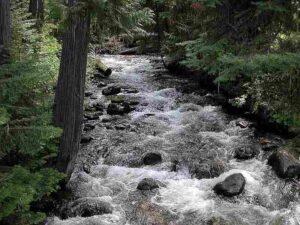
The transport of sediments and nutrients within river systems is influenced by flow trends. They influence the erosion and deposition of sediments, which, in turn, affect water quality and nutrient cycling.
Flow trends contribute significantly to the maintenance of biodiversity, as they regulate the conditions in which different species thrive [10]. Aquatic organisms, which include fish and macroinvertebrates, have evolved to tolerate specific flow conditions.
Primary productivity is also influenced by flow trends in river ecosystems. Algae and aquatic vascular plants, depend on flow-related factors such as sediment disturbance, light penetration, and nutrient availability. Variations in flow trends can disrupt these conditions, and affect autotrophic production.
Significance of Flow Trends in River Management and Conservation
Monitoring and analyzing flow trends is important for sustainable river management. The data derived from these procedures, helps in planning flood risk assessment, water resource allocation, and the preservation of critical habitats.
Flow trend data assists in the identification of potential alterations caused by human activities, such as land use changes, dam construction, and urbanization. This insight is critical for mitigating negative impacts on river ecosystems.
Common Flow Characteristics of Rivers
Flow characteristics of rivers include duration, intensity, number of flow events, and flow magnitude.
Flow duration is the proportion of time during which a specific discharge or flow rate is exceeded. An example of this is the duration of high or low flows.
Intensity of river flow is simply the rate at which water flows through a river. This is often expressed as discharge (cubic meters per second).
Flow volume estimates the total amount of water moved by the river over a given period, and is often measured in cubic meters or cubic feet.
The frequency of flow events, such as floods or low-flow periods, over a specified period of time is also a flow characteristic of rivers.
Lastly, flow magnitude measures the size or magnitude of flow events, which can range from small fluctuations to major floods.
Factors Influencing Flow Trends
Factors influencing flow trends in rivers include; climate change, land use alteration, and infrastructural development.
Alterations in temperatures and precipitation patterns can significantly impact the trend of river flow, in such a manner that potentially leads to more frequent and severe floods, or droughts.
Urbanization, deforestation, and large-scale agriculture in riverine areas, can modify the natural flow regimes by altering the catchment area of rivers.
The construction of levees, reservoirs and dams, can influence the flow of rivers and their associated ecosystems.
Flow Rate of Rivers and Streams
The flow rate of rivers and streams is usually measured in cubic meters per second (m³/s) or cubic feet per second (cfs). It quantifies the volume of water that passes a specific point in the river over a given time frame.
Conclusion
Abiotic factors in a river ecosystem are;
1. Sunlight
2. Water
3. Dissolved Oxygen
4. Sediments
5. Rocks
6. Physicochemical Parameters
7. Nutrients
8. Topography
9. Flow Trend
References
1). Afiukwa, J.; Afiukwa, C.; Oti, W. (2012). "DETERMINATION OF CALCIUM, MAGNESIUM AND TOTAL HARDNESS CONCENTRATIONS IN DRINKING WATER SUPPLY IN EBONYI STATE, NIGERIA." Continental J. Water, Air and Soil Pollution. 3. Available at: https://doi.org/10.5707/cjwasp.2012.3.1.12.16. (Accessed 17 September 2023).
2). Bilewu, O.; Ayanda, I..; Ajayi, T. (2022). "Assessment of Physicochemical Parameters in Selected Water Bodies in Oyo and Lagos States." IOP Conference Series: Earth and Environmental Science. 1054. 012045. Available at: https://doi.org/10.1088/1755-1315/1054/1/012045. (Accessed 17 September 2023).
3). Bulbul, A.; Abha, A. M. (2022). "Effects of dissolved oxygen concentration on freshwater fish: A review." Available at: https://doi.org/10. 113-127. 10.22271/fish.2022.v10.i4b.2693. (Accessed 17 September 2023).
4). Duffin, J.; Carmichael, R.; Yager, E.; Benjankar, R.; Tonina, D. (2021). "Detecting multi‐scale riverine topographic variability and its influence on Chinook salmon habitat selection." Earth Surface Processes and Landforms. 46. Available at: https://doi.org/10.1002/esp.5077. (Accessed 17 September 2023).
5). Dwaipayan, S.; Pramod, T. (2020). "An Overview of Nitrogen, Phosphorus and Potassium: Key Players of Nutrition Process in Plants." Available at: https://doi.org/10.1007/978-981-15-8636-1_5. (Accessed 17 September 2023).
6). Ferial, A. (2020). "Measurement of Alkalinity." Available at: https://www.researchgate.net/publication/339390457_Measurement_of_Alkalinity. (Accessed 17 September 2023).
7). Forcellini, M.; Laura, P.; Sylvain, D.; Sylvie, M.; Jean-Michel, O.; Sophie, C.-F.; Lamouroux, N. (2020). "Microhabitat selection by macroinvertebrates: generality among rivers and functional interpretation." Journal of Ecohydraulics. 7. 1-14. Available at: https://doi.org/10.1080/24705357.2020.1858724. (Accessed 17 September 2023).
8). Harte, P. T.; Richard, K. (2009). "Measured river leakages using conventional streamflow techniques: The case of Souhegan River, New Hampshire, USA." Hydrogeology Journal. 17. 409-424. Available at: https://doi.org/10.1007/s10040-008-0359-1. (Accessed 17 September 2023).
9). Kamarudin, M. K.; Toriman, M.; Noorjima, A. W.; Hafiz, M.; Frankie, A.; Mohd, F. (2017). "Sedimentation Study on Upstream Reach of Selected Rivers in Pahang River Basin, Malaysia." International Journal on Advanced Science, Engineering and Information Technology. 7. 35. Available at: https://doi.org/10.18517/ijaseit.7.1.971. (Accessed 17 September 2023).
10). Kim, B.-G.; Trina R.; Meagan, H.; Jessica, J.; Adrienne, K. E. Smokorowski, K. T.; Michael J. B.; Steven J. C. (2021). "How do natural changes in flow magnitude affect fish abundance and diversity in temperate regions? A systematic review protocol " Ecological Solutions and Evidence, Volume 2, Issue 2 e12079. Available at: https://doi.org/10.1002/2688-8319.12079. (Accessed 17 September 2023).
11). Maier, F.; Rood, S.; Hohensinner, S.; Becker, S. I.; Harmel, J.; Norbert, M.; Egger, G. (2021). "Mountain Rivers: A Global Overview of River Channel Forms, With a Focus on Braided Rivers." Available at: https://doi.org/10.1016/B978-0-12-819166-8.00159-6. (Accessed 17 September 2023).
12). Siobhan, F.; Julie, C. (2018). "Primary Production and Respiration: Ecological Processes in Wetlands." Available at: https://doi.org/10.1007/978-90-481-9659-3_67. (Accessed 17 September 2023).
13). Suther, B.; Leigh, D.; West, L. (2021). "Soil Chemistry and Clay Mineralogy of an Alluvial Chronosequence from the North Carolina Sandhills of the Upper Coastal Plain, USA." Soil Systems. 6. 1. Available at: https://doi.org/10.3390/soilsystems6010001. (Accessed 17 September 2023).
14). Wei, Y.; Jiao, Y.; An, D.; Li, D.; Li, W.; Wei, Q. (2019). "Review of Dissolved Oxygen Detection Technology: From Laboratory Analysis to Online Intelligent Detection." Sensors (Basel). 2019 Sep 16;19(18):3995. Available at: https://doi.org/10.3390/s19183995. (Accessed 17 September 2023).
